Intel Dual-Core Mobile Ivy Bridge Launch and i5-3427U Ultrabook Review
by Jarred Walton on May 31, 2012 12:01 AM EST- Posted in
- Laptops
- CPUs
- Intel
- Ivy Bridge
- Ultrabook
Ivy Bridge Ultrabook Gaming Performance
Okay, enough of the theoretical 3DMarks results. Let’s see how well ULV Ivy Bridge and HD 4000 can do in our gaming suite. (If you don’t care at all about gaming, just skip this page and move on.) I’ve only included the Value charts below, but I’ll summarize some additional gaming test results after the graphics. As always, if you want to know how we test games (or other applications) on laptops, please see our 2012 Mobile Benchmark Matrix.
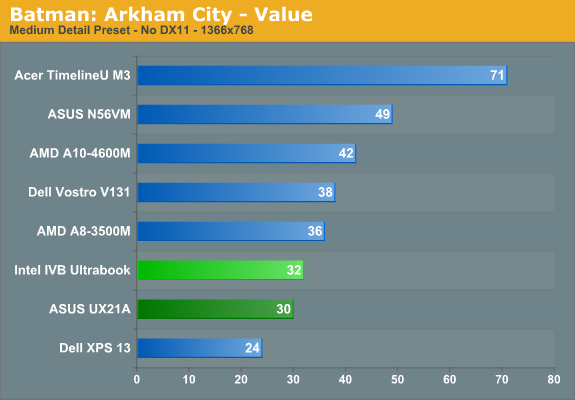
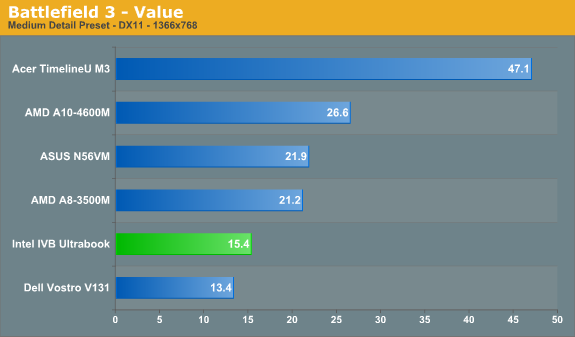
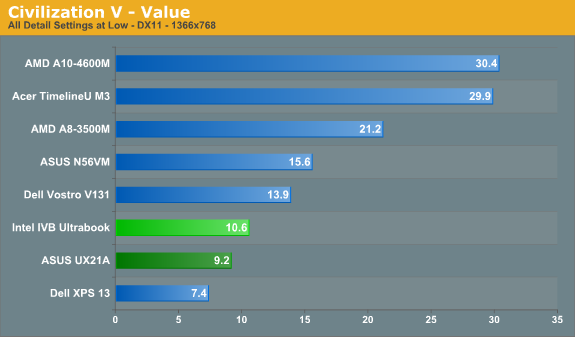

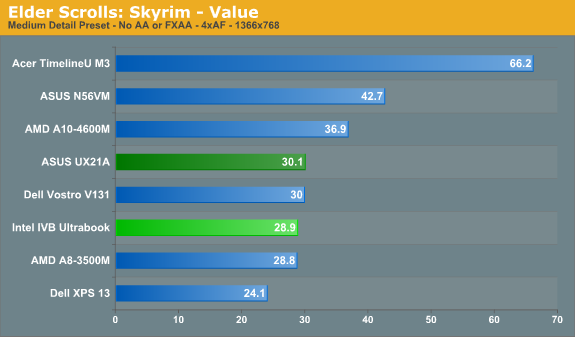
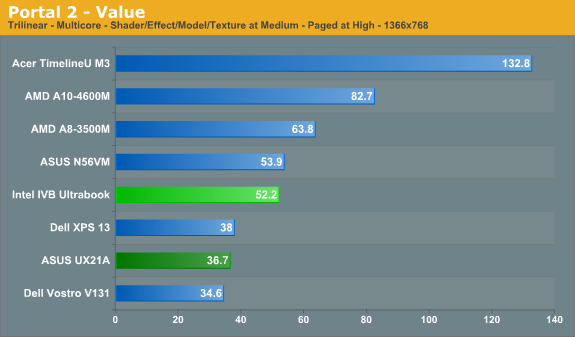
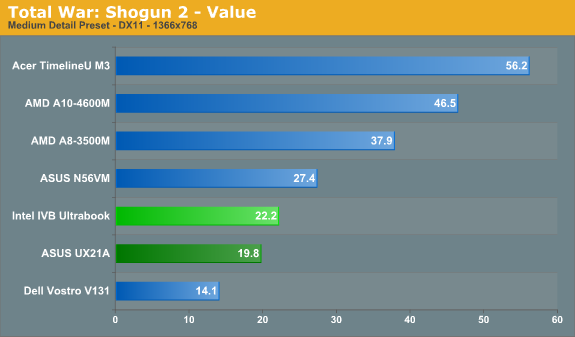
Obviously, gaming isn’t a strong suit of Ultrabooks that lack discrete graphics. The TimelineU is an Acer Ultrabook with Sandy Bridge ULV and an NVIDIA Kepler GT 640M DDR3 GPU, and it runs away from the IGP/APU-only competition in most games (Civilization V being the one exception where Trinity can close the gap). If your goal is 1366x768 gaming at medium detail settings, where the quad-core i7-3720QM manages to hit that mark in four of our seven games (five of eight if we count Diablo III—see below), it’s only in Portal 2 that ULV IVB is clearly above 30 FPS; it also basically reaches 30FPS (with periodic dips into the low 20s) in Batman, and the UX21A just barely breaks the 30FPS mark in Skyrim as well.
If you’re wondering about the score discrepancies between the IVB ULV prototype and the UX21A, Anand tested the UX21A with the currently official 2696 Intel drivers. Intel provided us with a 2725 beta driver for the prototype, and Portal 2 specifically has some performance issues fixed (and the memory leak issue we noticed in StarCraft II is also addressed).
Back on topic, ULV IVB basically isn’t going to cut it for medium detail gaming (our “Value” preset) in most titles. However, it’s a significant step up from ULV SNB if you look at the charts. We don’t have scores for the Dell XPS 13 in BF3 or TWS2, but in the other five titles the IVB upgrade is anywhere from 10% (DiRT 3) to over 40% (Civ5) faster, with most titles in the 20-35% range. Compared to a dual-core i5-2410M (Dell Vostro V131), ULV IVB isn't quite as successful, possibly because of thermal constraints. The V131 is sometimes substantially slower, but it does lead by a fair amount in Batman and Civilization V.
Unfortunately for gamers, HD 3000 Ultrabooks generally were incapable of reaching playable frame rates in most recent games, even at minimum detail settings. With the improved HD 4000 in Ivy Bridge, we decided to test our IVB Ultrabook at even lower settings just to see if dropping settings a bit more could bring the scores up; we tested at 1366x768 as well as 1600x900. We’ve also included our 1600x900 Mainstream gaming results in the following table, just in case you’re curious to see how badly IVB ULV fails at higher quality settings.
|
Ivy Bridge Ultrabook Gaming at Lower and Higher Quality Settings |
|||
|
1366x768 Minimum |
1600x900 Minimum |
1600x900 Mainstream |
|
| Batman: Arkham City | 33 | 27 | 18 |
| Battlefield 3 | 17.7 | 16.1 | 11.7 |
| Civilization V | 16.3 | 15.7 | 7.8 |
| DiRT 3 (Low) | 34.2 | 30.6 | 21 |
| Portal 2 | 53.3 | 47.8 | 25.6 |
| Skyrim | 33.7 | 29.5 | 17.5 |
| Total War: Shogun 2 | 56.4 | 47.4 | 15.1 |
At minimum/low detail settings (we didn’t drop all the way to Ultra Low in DiRT 3, though we did test that: it’s only about 1FPS faster than the Low setting), five of the seven titles reach playable frame rates. Somewhat surprisingly, most still look good as well; Skyrim and Shogun 2 at Low are probably the worst of the bunch, and they’re still tolerable. If you’re willing to drop settings this far, you can even bump the resolution up a notch in most games (assuming your Ultrabook sports a higher resolution LCD). Battlefield 3 and Civilization V on the other hand continue to be punishing on Intel hardware, and there's simply no good way to play them without an AMD or NVIDIA GPU to help out.
BF3 is a known beast, so that’s no surprise, but Civ5 has always been a sticking point for Intel and so we asked for some clarification on why performance in that title is so bad. The basic summary is that Civ5 tends to draw lots of very small objects, particularly in the LateGameView benchmark, and it doesn’t use instancing. We previously thought that the problem might be with geometry throughput on HD 3000/4000, but it looks like it might be more of a driver overhead issue that hits Intel harder than others. We’ve seen this problem with Civ5 before with relatively low frame rates even on high-end desktop GPUs; NVIDIA fixed this with some driver tweaks to improve performance on command lists, while AMD didn’t really address the issue until Southern Islands. At the very least, Intel knows about the issue and we may see a future driver that will address Civ5 performance—or we may have to wait for Haswell.
Going along with our normal gaming tests, we also did a brief look at Diablo III performance on several laptops. Many pointed out that the early portions of the game aren’t as demanding as later areas where monster mobs are larger and more spell effects are present. That’s certainly true, and we’re working on a better way to test Diablo III, but it’s not ready yet. In the meantime, I decided to perform a couple lengthy (around 20 minutes) FRAPS runs from late in Act I (Normal difficulty) and show those graphs. I played through several areas at 1366x768 with all settings on Low (but “Low FX” disabled), and I did the same at 1600x900. Average frame rates were 29.5 FPS at 1366x768 and 24.2 FPS at 1600x900, and here are the detailed charts:
Generally speaking, the 5FPS advantage for the lower resolution is consistent across around 30 minutes of gaming. Diablo III—at least in the earlier going—isn’t super demanding, and it’s possible to play it at 1600x900 on the IVB ULV Ultrabook, but it was a better experience at 1366x768 where frame rates are almost always above 20, and often in the 25-30 range. The dips in the above charts very likely coincide with battles with groups of monsters, and you can expect minimum frame rates in big battles in later acts to drop even further, so I wouldn’t recommend playing a hardcore character on this sort of laptop.
Naturally, if you want a better gaming experience, there are plenty of options to choose from. Are they as small and sleek as an Ultrabook? Generally speaking, no. The closest we’ve come to seriously thin gaming laptops might be the Sony VAIO Z, but the Acer TimelineU is definitely moving in that direction. Going forward, we expect to see quite a few Ultrabooks launching with some form of NVIDIA Optimus graphics. We already know about the TimelineU M3 and the ASUS UX32A; the TimelineU is a 14” laptop with typical Acer components (e.g. low quality screen, mediocre build quality), but it has a potent GPU. ASUS is going for a better built Ultrabook with a 1080p IPS LCD on some models (though not on the $799 model), but with a slower GT 620M GPU. The GT 620M is still a step up from the previous generation GT 540M, however, with core/shader clocks of 700/1400MHz, so it should provide for decent gaming. We’ll report more when we have a test unit in hand.
Update: If you're interested in further details on graphics performance and why the Ivy Bridge Ultrabook is quite a bit slower than the quad-core notebook, despite relatively close max iGPU clocks, we've posted a follow up article investigating real-time Ivy Bridge iGPU and CPU clocks while running games.


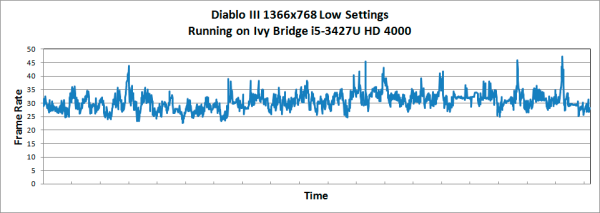
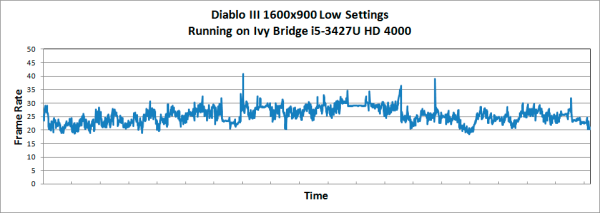








64 Comments
View All Comments
marioyohanes - Thursday, May 31, 2012 - link
Intel should learn from Apple users for the keyboard design... We all know how much Apple users hate white keyboard in previous MacBook models, that's why Apple is using black keyboard now...JarredWalton - Thursday, May 31, 2012 - link
Hahaha... I realized I never took a picture of the open laptop and so I used the image Intel sent along. I'll post an updated picture to the article in a moment, but suffice it to say that the review sample doesn't have a white keyboard.marioyohanes - Thursday, May 31, 2012 - link
I love the keyboard design on your new pic... :)kamalppc - Tuesday, January 29, 2013 - link
You can find the reviews here -http://cpudistro.com/intel/core-i5-3427u/
http://ultra-book.co/core-i5-3427u-review/
mcquade181 - Thursday, May 31, 2012 - link
I guess Apple users must value asthetics over funtionality!From a useablity point of view black keyboards are horrible.
In low light conditions it is very difficult to see individual keys, which, unless you can touch type, makes them very hard to use.
I suspect that's why there is so much desire for backlit keyboards.
Concillian - Sunday, June 3, 2012 - link
We should make keyboards for people who can't touch type?This is 2012 dude, if you can't touch type you have a problem. Everything you do in the business world and half the things in todays social world require using a keyboard of some kind as an input.
Catering hardware (and software) to the people who can't use them right ends up hindering productivity for those who are actually productive on their computer.
Argedut - Sunday, June 10, 2012 - link
You're totally right. Also if you don't understand the dewey decimal system don't even BOTHER looking for a job. Am I right?iwod - Thursday, May 31, 2012 - link
I am amazed by the Chipset TDP and die size, But as transistor shrinks but I/O lanes remain constant, may be we could further include things inside the chipset? Things like an SSD Controller? Or few years down the road there will be no more Chipset, just a SoC.Shadowmaster625 - Thursday, May 31, 2012 - link
The SSD controller should be right on the CPU die right next to the memory controller. But I guess Intel doesnt mind getting totally devoured by Apple, who was actually smart enough to make a chip with a flash controller. Granted its not a very fast one, but at least it is there.There is no reason why every new computer should not have at least 32GB of flash that reads just as fast as DRAM, and with DRAM caching, would basically write just as fast too. With the controller in the cpu it lowers the cost of 32GB to just a few dollars.... the current spot price of four 8Gbitx8 MLC NAND chips is just $18. With a good integrated flash controller, the lower latencies on random reads could bring the real world random read speeds well past even a Vertex 4.
ZeDestructor - Thursday, May 31, 2012 - link
What exactly is the difference between the QS77 and the QM77? As far as I can see, there's no reason to use the QM77 at all since the QS77 has a better TDP and power usage than the QM77 while retaining all the features...